Keeping bees is a wonderful experience that can transform you into a more mindful and more contented person. Whether you have a new-found passion for bees or just some time on your hands that you don’t know what to do with, keeping bees is something you can do without stress or huge expenses. Here’s how.
In this guide, we’ll talk about everything you need to know about keeping bees, from buying the right hive, to understanding the necessary equipment.
Keeping bees teaches you new skills, gets you out in the open air, and fills you with a positive feeling. And the best part? It’s easier than you may think.
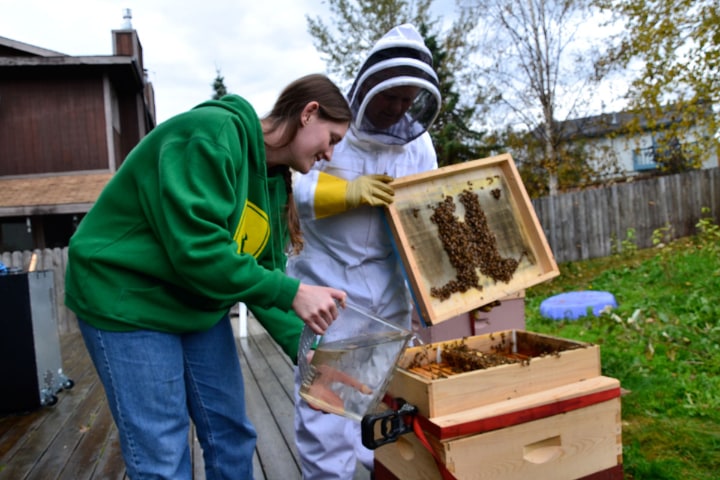
We’ll cover costs, show you how to harvest honey, share the best bee hive and bees suit recommendations, and answer all the key questions you have about keeping bees. So, are you ready for some honey—ahem—bees?
What Is Keeping Bees Like?
Many people wonder what keeping bees is like. Sure you’ve seen it in movies, but most of us have little idea of what it entails. It’s not like having a dog, is it?
Keeping bees is a great thing to do! First of all, it’s practical. At the moment, bees are an endangered species, so the planet needs all the help it can get. Second, it’s an endearing and heartwarming experience, just like keeping any other pet.
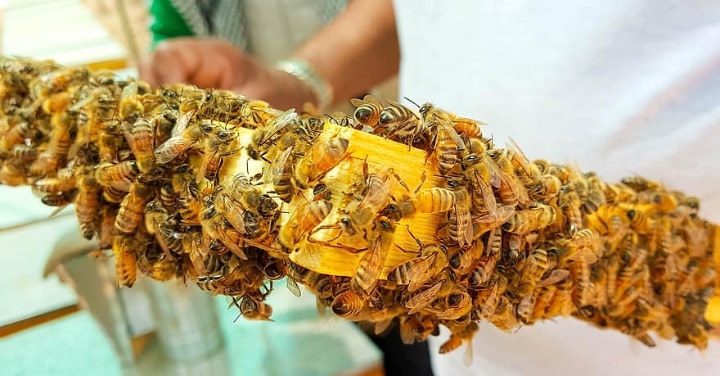
While bees may be off-putting or even scary to some, they are in truth fascinating creatures. And once you get to know them, as it were, you’ll find yourself spending more and more time outside with them, improving their habitat, and making friends.
So overall, keeping bees gets you out in fresh air, and allows you to learn about a wonderful creature. What’s there not to like?
Benefits of Keeping Bees
There are many benefits to keeping bees, some tangible, others not. Some people begin keeping bees just for the tangible benefits, looking to turn that into a lucrative profession, while others do it for both.
Honey
Honey has a myriad of health benefits. It feeds you nutrients, is choc-full of antioxidants and improves cholesterol and blood pressure. It’s also a great alternative to sugar, and indeed, you can also sell it.
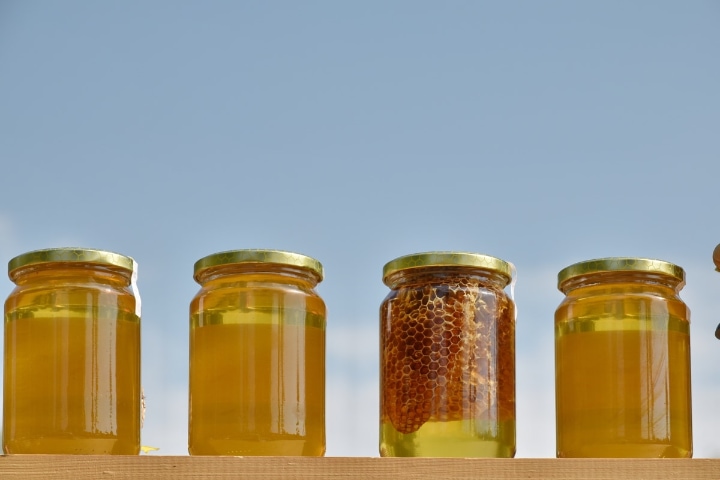
Remember: Perhaps one of the best aspects of producing your own honey is that you don’t expose yourself to all the additives and chemicals they put in store-bought honey.
Beeswax
Beeswax opens the door to another new hobby, which is creating natural skincare. Beeswax is an ingredient in many self-care products, from lip balms to face creams, thanks to its powerfully moisturizing properties.
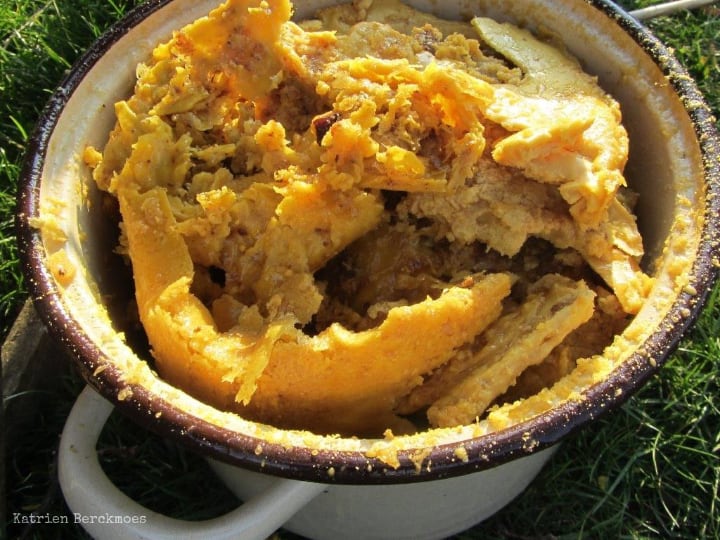
It’s also been shown to be an efficient treatment for acne, thanks to its rich vitamin A content.
Sustainability
In layman’s terms, sustainability refers to the ability of the environment and organisms to co-exist. If done right, beekeeping can improve sustainability. Most importantly, it stabilizes the number of pollinators, which allow wildflowers to grow.
There would be no flowers (and very little nature) if there weren’t any pollinators (aka bees). It’s not uncommon for a beekeeper to lend their bees to a farmer, in order to pollinate their farm.
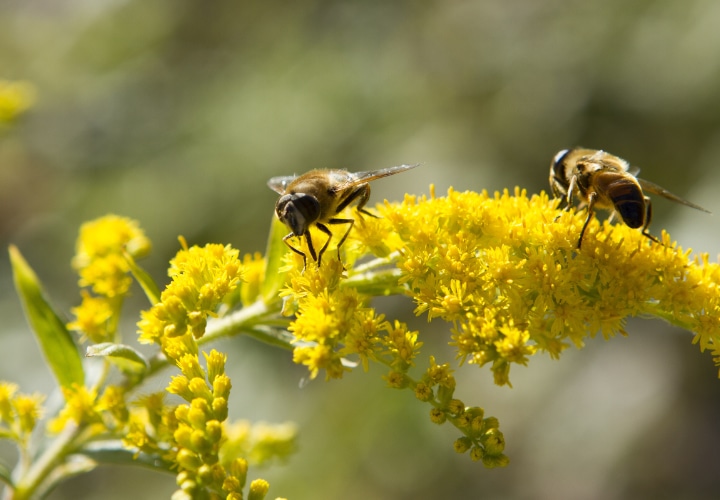
Important: Keeping bees helps sustain the natural rhythm of the animal food-chain, as several animals depend on honeybees to survive.
Lastly, beekeeping is what helps bees survive in many parts of the world, where they otherwise could not do it.
Wisdom
Yet another aspect of keeping bees is that it allows you to gain knowledge in a field you otherwise would know precious little about. It shows you the inner workings of the beehive and allows you a better understanding of nature.
Beekeeping makes you wiser to the cycle of life. In that sense, beekeeping can also lend one a sense of humility and awe at the impressiveness of nature.
Sense of Community
A beehive is all about community. The worker bees exist around the Queen Bee. Even more importantly, they work together to keep their beehive thriving.
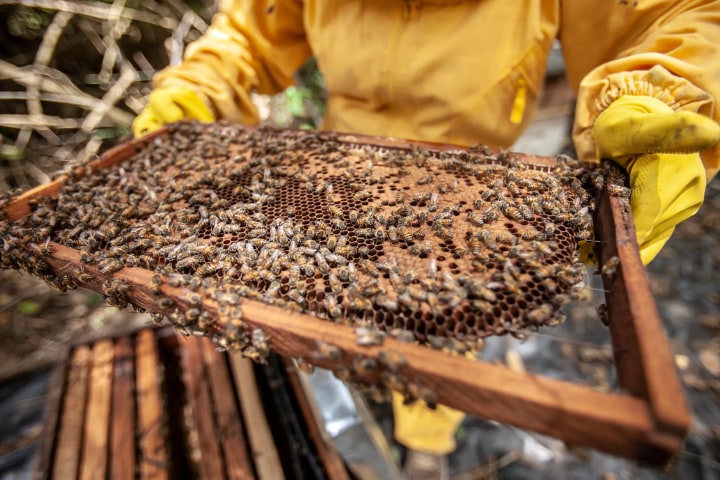
Now, if you compare that to humans, you soon see how we mostly work against each other, instead of together, as we should.
So, keeping bees can definitely give you a sense of community, and show you the importance of working together.
The Cost of Keeping Bees
Naturally, there are a number of costs to consider when getting into beekeeping. The supplies we mentioned earlier all cost, of course, as does the hive—whether you make it yourself or buy it from a store.
The nucleus of honeybees will also cost you a pretty penny.
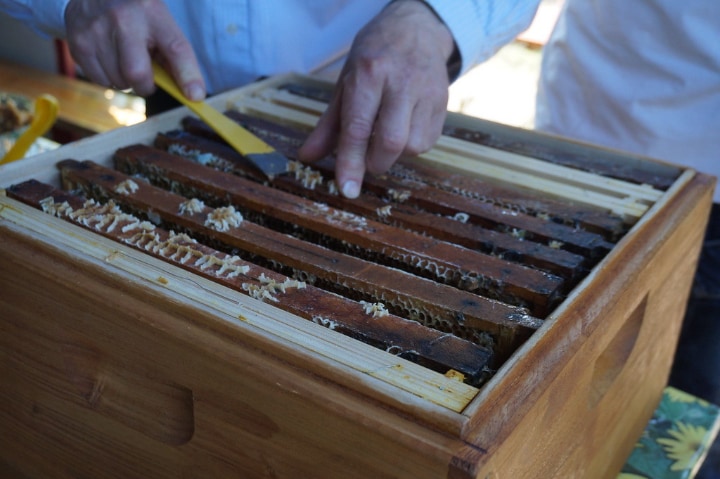
However, there are ways to save. Don’t just opt for the first item you find, but rather keep an eye out for sales, beginner’s kits, and discounts for bulk orders.
The Bottom Line: Depending on the type of equipment, bees and hive you buy, the whole operation can cost you less than $500. Of course, it can also cost you a lot more (it can easily go over $1,000), which is why it pays to take your time scouting out deals.
How to Start Keeping Bees
Maybe you like what you’ve read so far, and you’re thinking “man, I really could do this”. Yes, you can! Beekeeping is fun and has a hoard of benefits, even for the hobbyist beekeeper.
And if you’re not sure where to start, we’ve got you covered in this section.
Step 1 – Read Up on Beekeeping
It’s a tricky hobby, and it pays to learn as much as you can about it. Before you actually go out there and start buying beekeeping equipment (we’ll talk about that in a second), better get yourself a few books on keeping bees and learn all you can.
When you can easily answer the questions:
- How do bees make honey?
- How many bees does a nest usually have?
- How long does honey-making take?
Then you’re ready to move on to the next step.
Step 2 – Get a Hive
There are loads of excellent guides on how to build beehives, but it’s a process that takes time. While not necessarily hard, it can slow you down a bit.
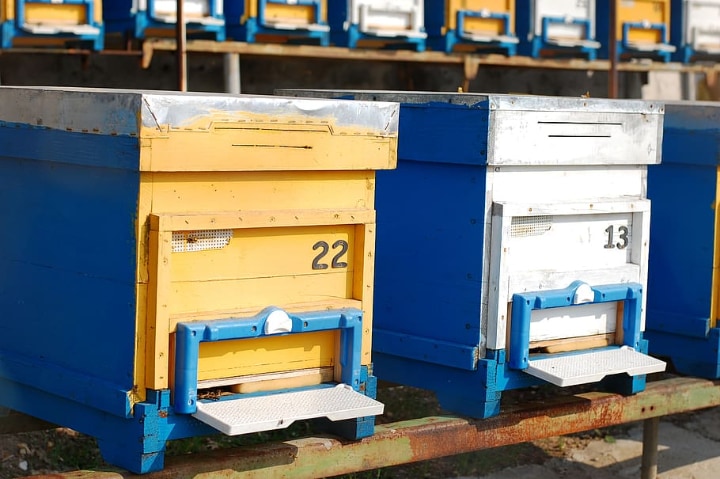
That’s why it’s usually easier to just buy a hive—unless of course, you’re a carpenter. You can find great ready-made beehives at specialty stores as well as online. We’ll share with you some recommendations later on in this post.
Step 3 – Buy Supplies, But Don’t Go Crazy
When you’re just starting out (here, as in any other hobby), you’re tempted to splurge and buy anything with the word ‘bees’ on it.
Don’t. It’s impractical and unnecessary. Instead, figure out what you will need to keep happy bees, and get that—and only that!
Interestingly enough, while it seems a complicated hobby, there are only a handful of things you need to start keeping bees. There is, of course, the hive, which we already mentioned.
Protective Gear
Protective gear is another important aspect, although opinions are mixed on the efficiency of a full-blown beekeeping suit (we’ll talk about that later on).
At the very least, you want a beekeeper’s veil, to shield your head, and gloves. You’ll also need to wear covering clothing, to minimize the risk of being stung.
Smoker
Another important thing you’ll need is the smoker. This is a very interesting tool. It infiltrates smoke into the beehive, which makes it impossible for bees to communicate temporarily.
This means they can’t tell each other of the potential threat (e.g. the beekeeper, in this case), and won’t attack while you inspect the hive or remove the honey.
Bee Brush
You can use bee brush is used to gently swipe off the bees if they are in your way. It’s particularly useful when you’re extracting the honey but you can also use it in other beekeeping maintenance activities.
Opinions on the usefulness of a bee brush are mixed, with some beekeepers being opposed to it since it risks damaging the wings and legs of the bee, especially when used often. Really, this depends on the beekeeper.
Honey Extraction Equipment
You’ll also want some extracting equipment (basically a tool that extracts the honey by a pulling force), to obtain that sweet honey. You can either buy these or see if you can rent them from your local bee keeping community.
Step 4 – Contact Your Local Bee Keeping Community
Since you’re learning about community, keeping bees can also be a great chance for you to become part of a community. Contacting your local bee keeping community has its’ own set of benefits.
It allows you to learn from experienced beekeepers, as well as ask for help (be it practical or theoretical) whenever in a sticky situation.
Step 5 – Order Your Bees
Once you have your supplies and have read up on what keeping bees will entail, there’s nothing left for you to do but actually order the bees. This will be the best way for you to learn and gather some hands-on experience.
How to Harvest Honey
Okay, so we’ve got the bees, we’ve got the hive, now on to the honey harvesting. But how do you actually harvest it? Below is a quick and easy beginner’s guide to getting honey.
Step 1 – Smoke ‘em
The first step is to use the smoker around the hive entrance, to stop the bees from sensing danger and attacking you. Very gently, open the hive, and puff some more smoke in, to push the bees further back.
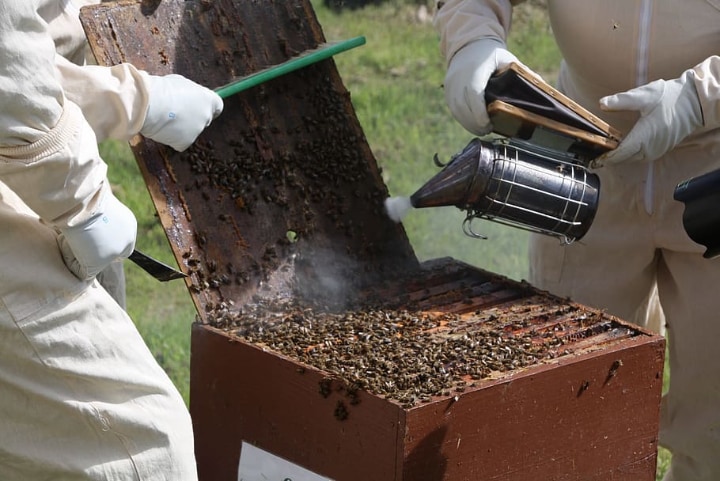
Step 2 – Remove Any Bees from the Area
If you’re just harvesting one frame, that’s okay, but you’ll still want to remove all the bees from the area. You can do this either using the brush mentioned above, or another special tool, such as a bee blower.
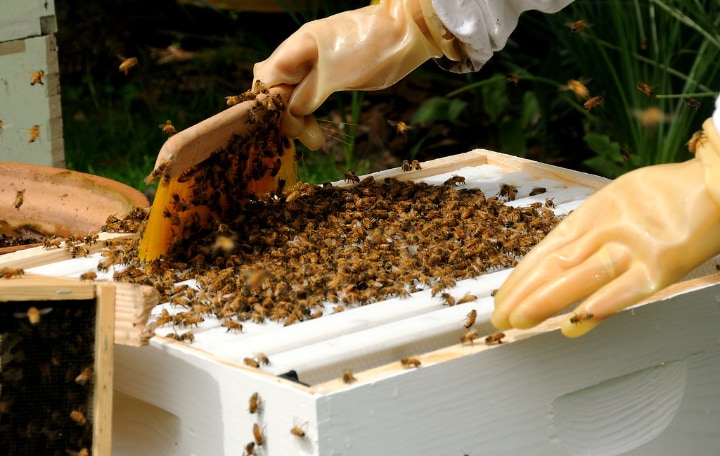
Step 3 – Uncap the Honeycomb
You’ll need a special comb, fork, or another such tool for uncapping the honeycomb from its waxy home.
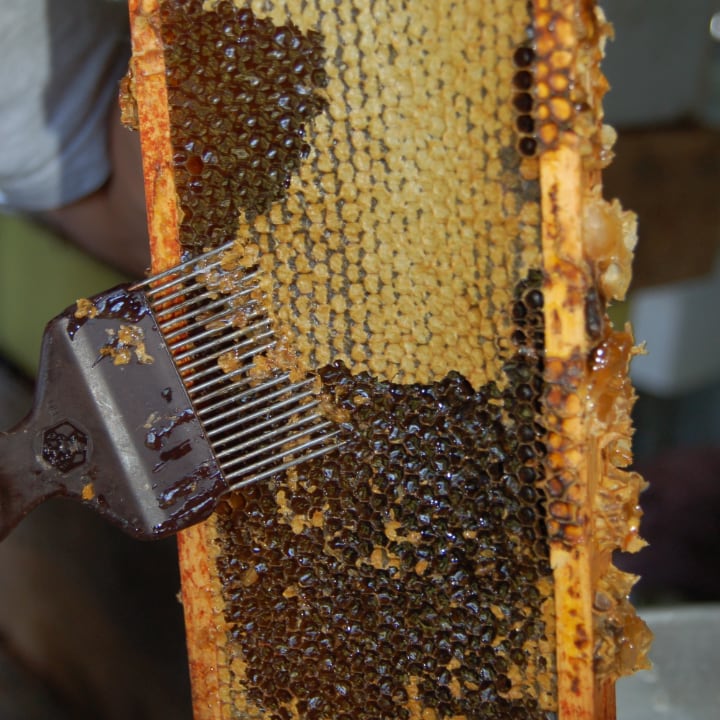
Step 4 – Get That Honey!
For this, you will need a honey extraction tool. Simply place the frame (or frames) inside the extractor and begin spinning.
This process will extract the honey from the frame and unto the walls of the extractor. From here, it will slowly drip down, gathering at the bottom.
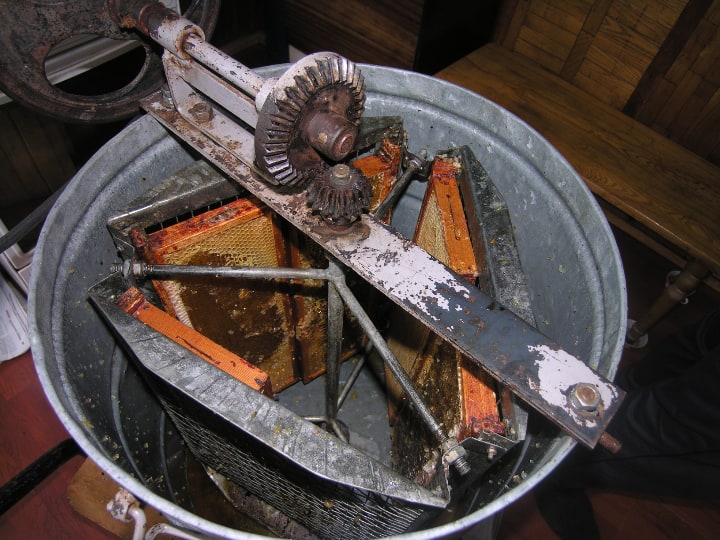
Honey extractors are either manual (e.g. you’ll have to spin a hand-crank to get the honey out), or electric.
Step 5 – Filter. Filter. Filter
Filtering your honey is an important part of the process, as it removes any stray bits of wax or any other impurity. There are, of course, special honey strains that you can use for this.
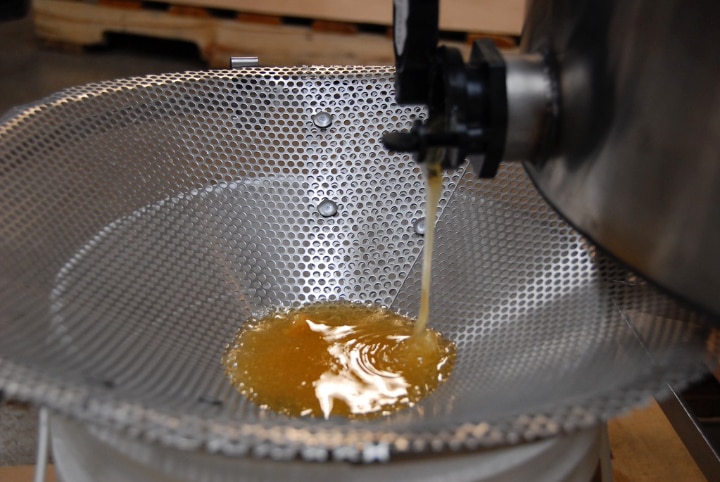
Tip: Alternatively, you can layer a few pieces of cheesecloth one over the other, and they should do the same job.
Step 6 – Bottle It Up
Once your honey has properly been filtered, it’s ready to be bottled up into jars.
Keeping Bees for Honey Tips
In truth, the best way to “learn the trade” is to actually keep bees. Through hands-on experience, you will gather all the knowledge there is about beekeeping.
Here are some beekeeping tips to get you started on the right foot.
1. Pick the Right Spot for Your Hive
You want a place in your yard that is easy to access so that you can spend as much time as possible with your bees. Try to integrate your bee hive into your overall backyard design.
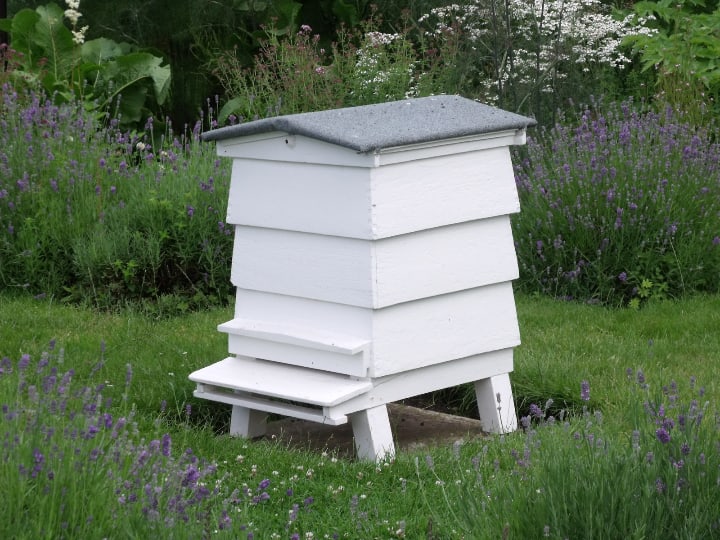
You also want to make sure the bees get at least half a day of sun. The sun is good because it keeps the hive beetle away.
Tip: The sun must hit your bee hive in the morning, to wake up the bees.
2. Stick to Frames
We’ve already mentioned frames, but beware that there are many other types of hives, some of which don’t use frames. You may want to look for a hive that does have frames, as it makes honey extraction and hive inspection a whole lot easier.
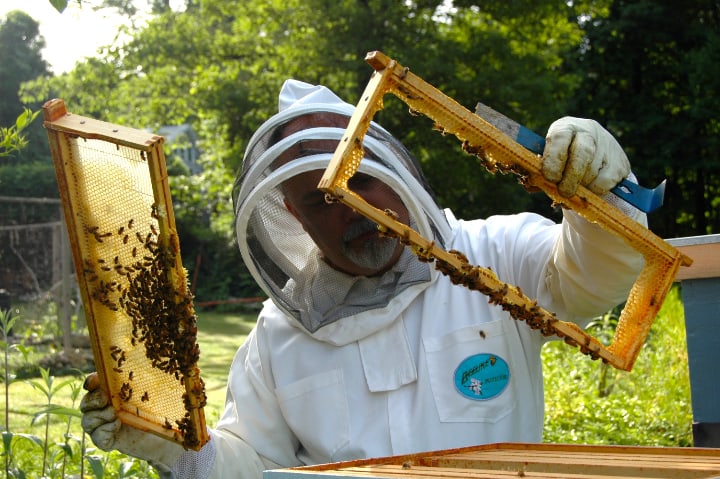
3. Split Up Your Hives
Most professional beekeepers keep more than one hive, and that’s not just because it yields more honey. Having multiple hives makes the extraction process easier, and also makes the hives more manageable.
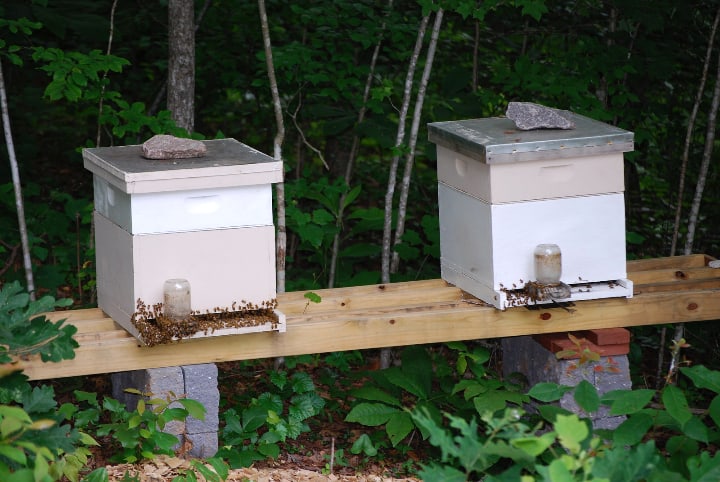
For example, if one colony is weaker than the other, you can transfer pollen or brood to “beef it up.”
Types of Bees to Buy
Before you actually begin your beekeeping adventure, you will have to settle on a type of bee, of course. Not all bees are the same, so here are a few buying ideas to get you started:
- The Western Honey Bee (or Apis Mellifera) is the most common honeybee, and the most widely-bred.
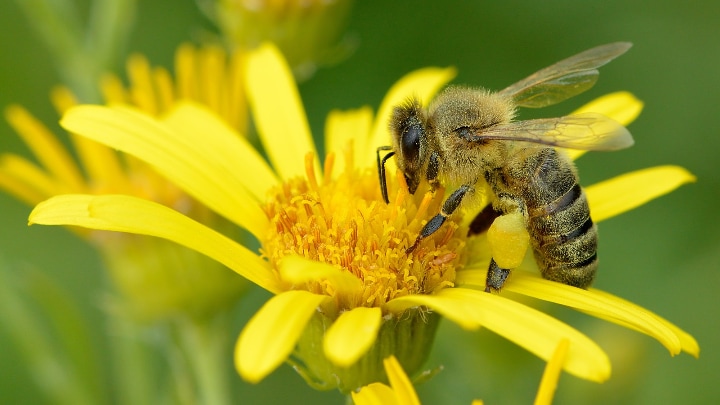
- The Italian Honey Bee (or Apis Mellifera Liguistica) is a very popular type of honey bee, although a bit trickier to keep, thanks to its strange understanding of loyalty and community.
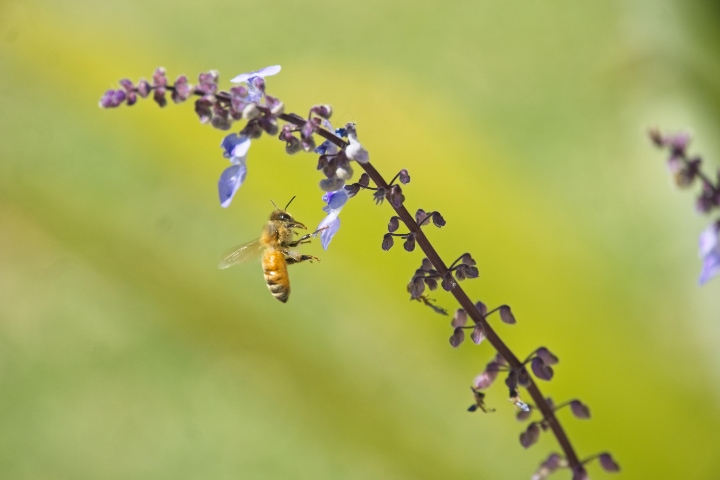
- The Dark/German Honey Bee (or Apis Mellifera Mellifera) is adapted to colder and damper atmospheres than the previous two.
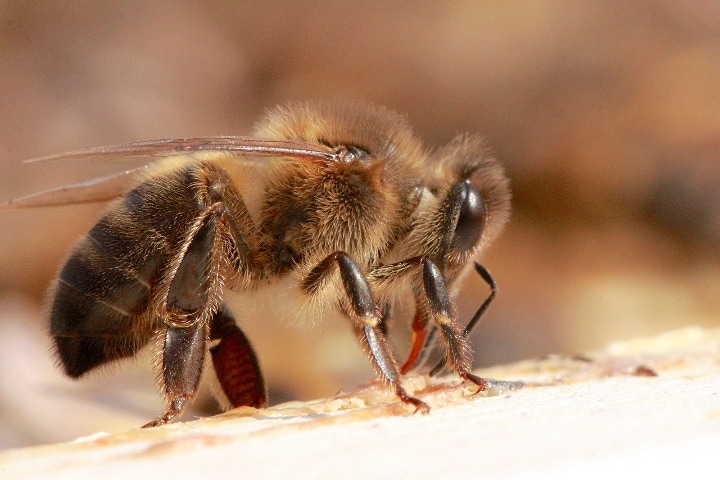
- The Carniolan/Grey Honey Bee (or Apis Mellifera Carnica) isperhaps the best for beginners, as they are very gentle and easy to work with.
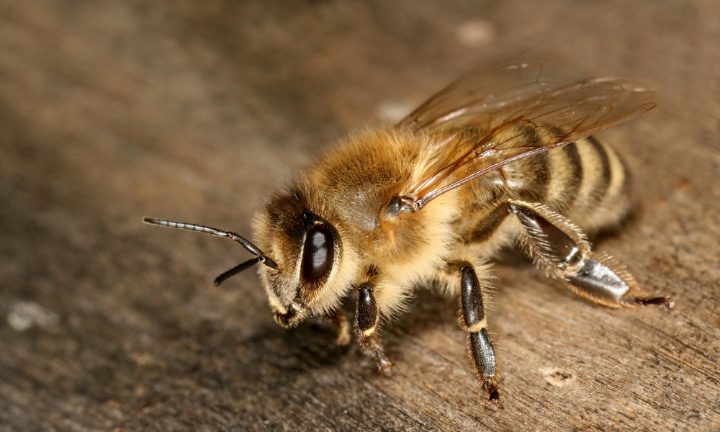
- The Caucasian Honey Bee (or Apis Mellifera Caucasica) is also a very gentle sort of bee, albeit significantly slower at building up a colony.
Fun Fact: All honey bees belong to the Apis genus, which has over 44 different types of bees.
Bee Hives for Sale
If you’re not too keen on building your hive, there are plenty of excellent hives for sale online (as well as at specialty stores). Naturally, you’ll have to pick your own, depending on climate, the space available, expertise, and so on.
Below are some of our favorites, just to get you started:
Complete Bee Hive Kit by 10 Frames
The great thing about this kit is that it has frames, which, again, is important. It’s also well-built and has excellent reviews both from beginners as well as experienced beekeepers.
Hoovers Hive by Langstroth
The Hooves hive is dipped in wax, which protects the wood and gives it a more natural, appealing look. It’s a beautifully crafted piece that is easy to assemble and use. It seems to be long-lasting and spacious.
Bee Hive Kit by Mann Lake
This piece also comes with 10 separate frames, which is ample for extracting honey. While its white exterior makes it look less ‘natural’ at first, it allows you more decorating space and gives you a chance to make the hive your own.
Overall it’s very sturdy and easy to manage.
Insulated Plastic Bee Hive Set by Apimaye
This hive comes with a designated queen separator. According to reviews, it’s sturdy and long-lasting so that you can use it for many years. One huge benefit is that it’s insulated and keeps well in most climates.
Keeping Bees in Suburban Areas
Do you live in a suburban area? You might be worried about keeping bees but you don’t have to be. Truth is, you need very little space in your yard for a beehive.
But before you decide to take up beekeeping in a suburban area, make sure your neighbors are okay with it.
It doesn’t hurt to explain to them that bees are generally gentle creatures (even more so than rabbits!) and your beehive won’t beef up the bee population in their yard.
Once that’s done, make sure you read up on local laws and regulations about keeping bees, to see what rules there are that you need to be aware of.
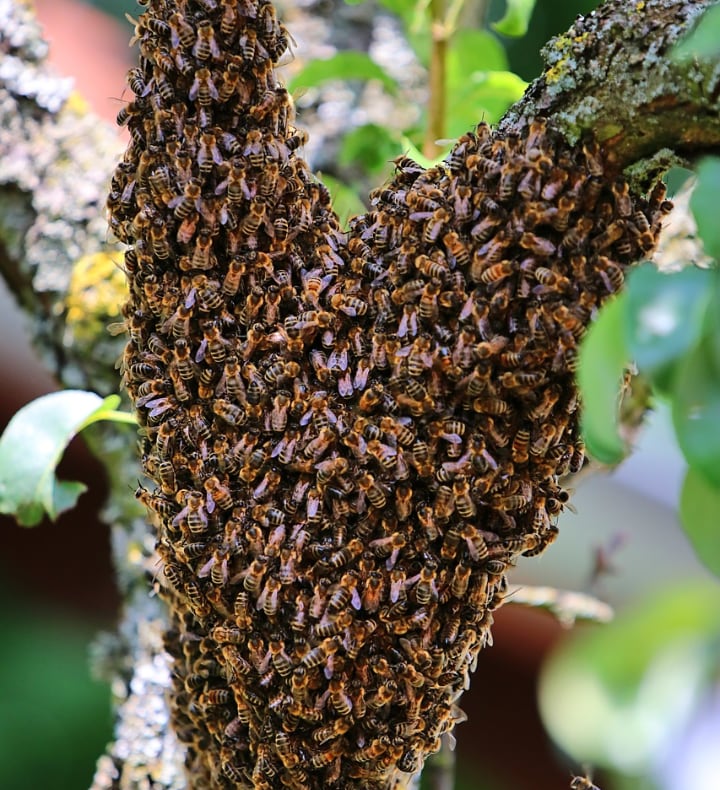
Good to know: Bees swarm to divide a colony, and this usually happens when a colony has become too large. To prevent this, make sure you split your colonies often, especially strong ones.
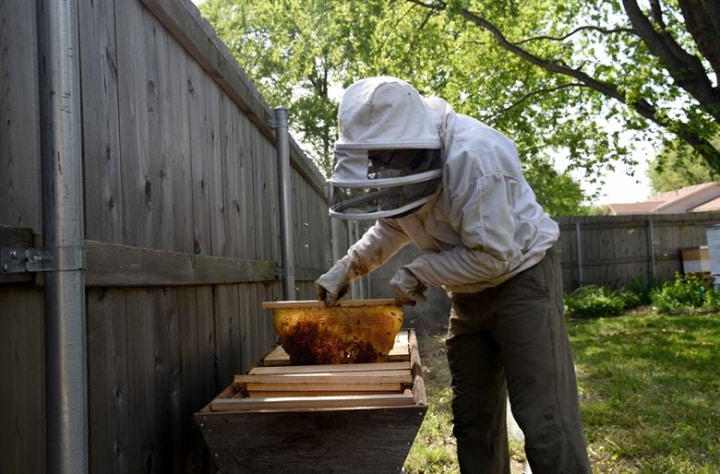
Remember, while a swarm of bees isn’t anything special to a beekeeper, it can be frightening to the general population.
Why You Need a Bees Suit
A bees suit will cover you from head to toe and is the ideal get-up when approaching your beehive for some maintenance or honey extraction. This will not only protect you from coming into direct contact with the bees, but it may also save their lives.
Remember, honey bees do not want to sting you since they die after a single sting. However, they will do so if they feel threatened. By making it impossible for them to sting you, you are protecting both yourself and your hive.
How to Choose a Bees Suit
This will vary heavily from person to person. A good idea would be to try the suit out at a local store if possible. Since you’ll be spending a lot of time (more than an hour, usually) in it, you want to make sure it’s comfortable and not too hot.
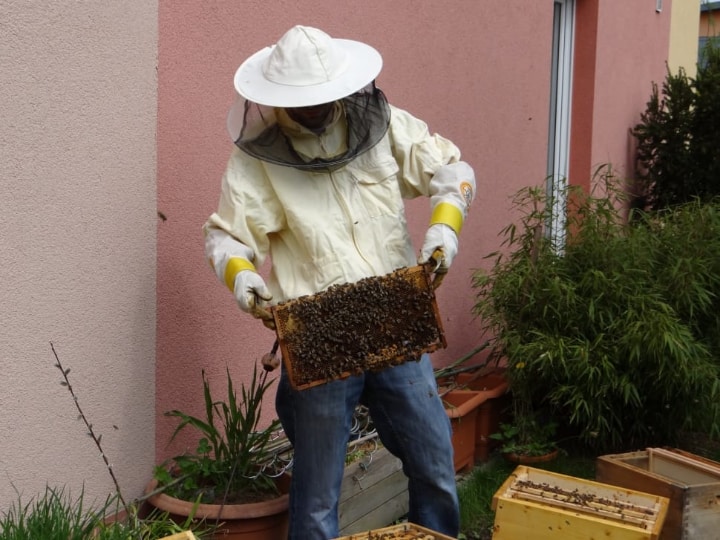
Important: You want to choose a suit that allows you to move freely and easily. Some beekeepers shun such suits precisely because they make it harder to care for the bees.
Bees Suit for Sale
There are many excellent bees suits out there, and with enough patience, you can find the right one. Here are our recommendations.
Beekeeping Suit by Reliancer
This cotton-based bees suit offers complete and reliable protection while remaining breathable. This makes it easy to wear for extended periods outside in the sun.
It puts 5 millimeters between you and the bees, which is more than enough to keep both of you safe.
Humble Bee 410 Polycotton Suit
Half cotton, half synthetic blend, this polycotton Humble bee suit seems to be sturdy enough and offers ample protection. Some people had trouble with the zippers, but overall, it looks like a good value for money.
Ultra Breeze Large Beekeeping Suit
An interesting mix of polyester and vinyl, this suit is a bit on the pricey side, but it’s well worth the money. It has excellent ventilation, which makes it ideal for long-wearing periods, and surprisingly breathable, even in hot weather.
It also comes in a wide array of sizes, making it easy to find the right fit for you.
Honey Lake Children’s Beekeeping Suit
If you have kids, chances are they’ll want to take part in your beekeeping activities. This Honey Lake suit is made of cotton, which makes it easy to wear (even in summer), and highly breathable.
It also offers good, sturdy protection against bee stings, and comes in enough sizes so you should be able to find the right one for any child.
Keeping Bees FAQs
Still got questions? Explore now some of the most commonly asked questions about keeping bees that we get.
How do I start keeping bees?
You start beekeeping by learning all you can about bees, and then by actually keeping bees. The best learning is hands-on, so don’t be afraid to try. Follow our step-by-step beekeeping guide for a more in-depth look at keeping bees.
How much does it cost to keep bees?
Depending on your area and the quality of products bought, you can expect to spend anywhere from $350 to over $1000 to get into beekeeping. These costs will cover accessories, the hive, the colony itself, as well as any treatment against pests. Find out more about the costs of keeping bees.
Is it easy to keep honey bees?
Yes! Keeping bees is easier than most people assume. All you need is the right equipment, willingness to learn, and of course, patience.
Is it safe to keep bees in your backyard?
Of course. While you will have to take special care of your bees, beekeeping in your backyard, when done right, is perfectly safe if you get a bees suit.
Ready for Your Beekeeping Honeymoon?
Beekeeping can be educational and exciting, not to mention very useful. It’s a great way to fill some time, if you’re looking for a new hobby, and may well develop into a lucrative side-gig if given enough time and effort.
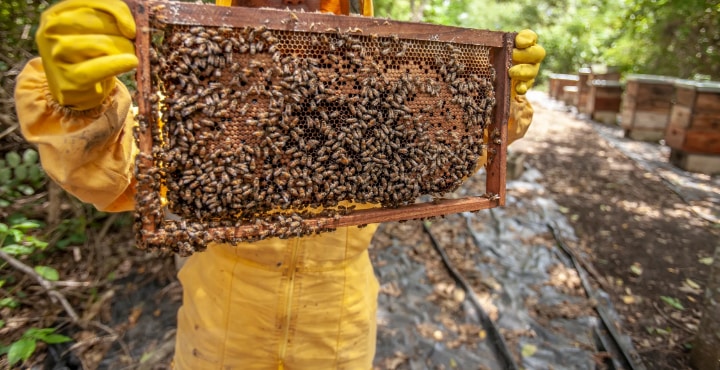
One thing is for certain, you’ll fall in love with your bees once you get them. And when you start passing that delicious honey around, you’ll be the buzz of the town! (Or if you’re the quiet type, you can drink it with some chamomile tea.)
PS: Don’t forget to tell us about your beekeeping adventures. We’d love to hear from you! Drop us a comment here or reach out to us on social media.

Leave a Reply